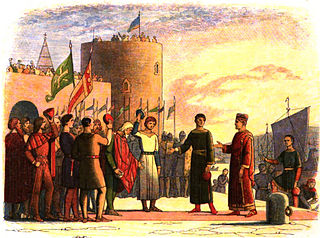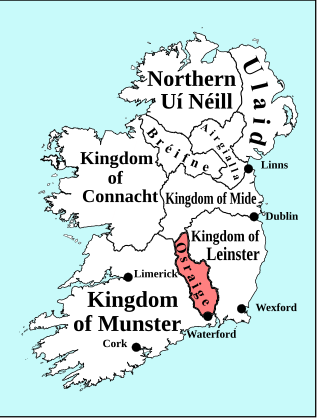| |||||
| Centuries: | |||||
|---|---|---|---|---|---|
| Decades: | |||||
| See also: | Other events of 1151 List of years in Ireland | ||||
Events from the year 1151 in Ireland.
| |||||
| Centuries: | |||||
|---|---|---|---|---|---|
| Decades: | |||||
| See also: | Other events of 1151 List of years in Ireland | ||||
Events from the year 1151 in Ireland.
The Battle of Móin Mhór was fought in 1151 between the kingdoms of Leinster and Thomond in Ireland. The Kingdom of Leinster was victorious.

Year 1171 (MCLXXI) was a common year starting on Friday of the Julian calendar.

Leinster is one of the provinces of Ireland, situated in the southeast and east of Ireland. The province comprises the ancient Kingdoms of Meath, Leinster and Osraige. Following the 12th-century Norman invasion of Ireland, the historic "fifths" of Leinster and Meath gradually merged, mainly due to the impact of the Pale, which straddled both, thereby forming the present-day province of Leinster. The ancient kingdoms were shired into a number of counties for administrative and judicial purposes. In later centuries, local government legislation has prompted further sub-division of the historic counties.
There have been four Provinces of Ireland: Connacht (Connaught), Leinster, Munster, and Ulster. The Irish word for this territorial division, cúige, meaning "fifth part", suggests that there were once five, and at times Meath has been considered to be the fifth province; in the medieval period, however, there were often more than five. The number of provinces and their delimitation fluctuated until 1610, when they were permanently set by the English administration of James I. The provinces of Ireland no longer serve administrative or political purposes but function as historical and cultural entities.

The Irish Rugby Football Union (IRFU) is the body managing rugby union in the island of Ireland. The IRFU has its head office at 10/12 Lansdowne Road and home ground at Aviva Stadium, where adult men's Irish rugby union international matches are played. In addition, the Union also owns the Ravenhill Stadium in Belfast, Thomond Park in Limerick and a number of grounds in provincial areas that have been rented to clubs.
Diarmait Mac Murchada, anglicised as Dermot MacMurrough, Dermod MacMurrough, or Dermot MacMorrogh, was a King of Leinster in Ireland. In 1167, he was deposed by the High King of Ireland, Ruaidrí Ua Conchobair. The grounds for the deposition were that Mac Murchada had, in 1152, abducted Derbforgaill, the wife of the king of Breifne, Tiernan O'Rourke. To recover his kingdom, Mac Murchada solicited help from King Henry II of England. His issue unresolved, he gained the military support of the 2nd Earl of Pembroke. At that time, Strongbow was in opposition to Henry II due to his support for Stephen, King of England against Henry's mother in the Anarchy. In exchange for his aid, Strongbow was promised in marriage to Mac Murchada's daughter Aoife with the right to succeed to the Kingship of Leinster. Henry II then mounted a larger second invasion in 1171 to ensure his control over Strongbow, resulting in the Norman Lordship of Ireland. Mac Murchada was later known as Diarmait na nGall. He was seen in Irish history as the king that invited the first-ever wave of English settlers, who were planted by the Norman conquest. The invasion had a great deal of impact on Irish Christianity, increasing the de facto ability of the Holy See to regulate Christianity in Ireland.

Ruaidrí mac Tairrdelbach Ua Conchobair was King of Connacht from 1156 to 1186, and High King of Ireland from 1166 to 1198. He was the last High King of Ireland before the Anglo-Norman invasion.
Toirdhealbhach Mór Ua Conchobhair anglicised Turlough Mór O'Conor, was King of Connacht (1106–1156) and High King of Ireland.

The Book of Leinster is a medieval Irish manuscript compiled c. 1160 and now kept in Trinity College, Dublin, under the shelfmark MS H 2.18. It was formerly known as the Lebor na Nuachongbála "Book of Nuachongbáil", a monastic site known today as Oughaval.

The kings of Osraige reigned over the medieval Irish kingdom of Osraige from the first or second century AD until the late twelfth century. Osraige was a semi-provincial kingdom in south-east Ireland which disappeared following the Norman Invasion of Ireland. A number of important royal Ossorian genealogies are preserved, particularly MS Rawlinson B502, which traces the medieval Mac Giolla Phádraig dynasty back through Óengus Osrithe, who supposedly flourished in the first or second century. and one in the Book of Leinster. Recent analysis of ninth and tenth century regnal succession in Osraige has suggested that in peaceful times, kingship passed primarily from eldest to youngest brother, before crossing generations and passing to sons and nephews.

The history of Ireland 800–1169 covers the period in the history of Ireland from the first Viking raids to the Norman invasion. The first two centuries of this period are characterised by Viking raids and the subsequent Norse settlements along the coast. Viking ports were established at Dublin, Wexford, Waterford, Cork and Limerick, which became the first large towns in Ireland.
Tighearnán Mór Ua Ruairc, anglicised as Tiernan O'Rourke ruled the kingdom of Breifne as the 19th king in its Ua Ruairc dynasty, a branch of the Uí Briúin. He was a descendant of Uí Riagain, and one of the provincial kings in Ireland in the twelfth century, constantly expanding his kingdom through shifting alliances, of which the most long-standing was with Toirdelbach Ua Conchobair King of Connacht and High King of Ireland, and subsequently his son and successor Ruaidhrí Ua Conchobair. He is known for his role in the expulsion of Diarmait Mac Murchada, King of Leinster, from Ireland in 1166. Mac Murchada's subsequent recruitment of Marcher Lords to assist him in the recovery of his Kingdom of Leinster ultimately led to the Norman invasion of Ireland.
The Battle of Móin Mhór was fought in 1151 between the kingdoms of Leinster and Thomond in Ireland. The Kingdom of Leinster was victorious.
The Uí Dúnlainge, from the Old Irish "grandsons of Dúnlaing", were an Irish dynasty of Leinster kings who traced their descent from Dúnlaing mac Énda Niada. He was said to be a cousin of Énnae Cennsalach, eponymous ancestor of the rival Uí Chennselaig.

The Anglo-Norman invasion of Ireland took place during the late 12th century, when Anglo-Normans gradually conquered and acquired large swathes of land from the Irish, over which the kings of England then claimed sovereignty, all allegedly sanctioned by the Papal bull Laudabiliter. At the time, Gaelic Ireland was made up of several kingdoms, with a High King claiming lordship over most of the other kings. The Norman invasion was a watershed in Ireland's history, marking the beginning of more than 800 years of direct English and, later, British, involvement in Ireland.

The Battle of Tara was fought between the Gaelic Irish of Meath, led by Máel Sechnaill mac Domnaill, and the Norse Vikings of Dublin, led by Amlaíb Cuarán. It took place near the Hill of Tara in Ireland in the year 980. The battle was a devastating defeat for the Vikings and led to the Irish regaining control of Dublin.
Events from the year 1169 in Ireland.
Derbforgaill, Dearbhfhorgaill or Dearbhfhorghaill may refer to:
Loígis is the name of an Irish tribe, as it is called by contemporary scholars. Formerly, scholars generally called the tribe Laoighis or Laeighis in Irish, Lagisia in Latin, and Leix in English. Loígis is also the name of the territory in western Leinster that the tribe settled during the third century AD, and of the minor kingdom that the Loígis chieftains ruled until 1608. County Laois derives its name from Loígis, although the present county encompasses baronies that were not traditionally part of the territory of Loígis.